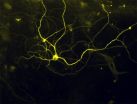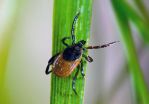(Press-News.org) VIDEO:
When zebrafish are infected with bright blue Mycobacterium marinum, bright red immune cells quickly surround the bacteria to form tightly organized nuggets called granulomas (vessels green, bacteria blue, immune cells...
Click here for more information.
DURHAM, N.C. -- The body responds to tuberculosis infection by locking the bacterial offenders into tiny clusters of immune cells called granulomas, which are a hallmark of the disease. This containment strategy succeeds at first, but eventually the bacteria manage to break out of these intercellular jails and spread throughout the body.
Now, researchers have shown that this escape is aided by new blood vessels that tunnel into the granulomas, providing fresh oxygen and a way out for the bacteria held inside. They tested FDA-approved drugs that block this process -- known as angiogenesis -- and found they could effectively reduce the numbers of bacteria, limit their spread outside of granulomas, and increase the survival of infected laboratory animals.
The findings, which appear online Nov. 24 in Nature, suggest a new therapeutic approach that might target the body's response to tuberculosis (TB) rather than going after the bacteria directly.
"Angiogenesis is a host response that can be triggered by granulomas, and the bacteria take advantage of it to grow and to maintain a sufficient supply of oxygen, and ultimately to spread," said David M. Tobin, Ph.D., an assistant professor of molecular genetics and microbiology at Duke University School of Medicine.
"We think that anti-angiogenic agents, commonly used for cancer, could be an entirely new avenue for treating TB," Tobin said. "This sort of host-directed therapy would be particularly effective in cases of multi-drug-resistant disease where current antibiotic regimens fail."
Tuberculosis is a leading cause of death from infectious diseases worldwide, second only to HIV/AIDS. A recent report from the World Health Organization found that 9 million people developed TB and 1.5 million died from the disease in 2013 alone. Though there are several drug regimens approved to treat the illness, these treatments can be time-consuming, toxic, and ineffective against the most drug-resistant strains.
Researchers have pursued alternative therapies for TB using a variety of animal models, including the zebrafish found in many pet stores and household aquariums. The tiny fish can be infected by its natural pathogen Mycobacterium marinum, a close cousin to Mycobacterium tuberculosis, the bacterium that causes human TB.
Obviously, the fish don't have lungs, but they do develop granulomas that are structurally similar to those found in human TB patients.
Tobin, who helped to develop the zebrafish as a model of TB, decided to use the system to study the blood vessels associated with granulomas. He and his postdoctoral fellow, Stefan H. Oehlers, Ph.D., wanted to determine whether these new blood vessels were benefiting the host or the bacteria.
Because zebrafish are transparent until their stripes emerge in adulthood, Oehlers could label the bacteria, immune cells, and vasculature with differently colored fluorescent tags and then follow a TB infection over time. When he infected zebrafish with bright blue Mycobacterium marinum, he saw bright red immune cells quickly surround the bacteria to form tightly organized granulomas. Within days, bright green blood vessels could be seen sprouting in and around these little balls of cells. They found that the new vessels were functioning blood vessels carrying red blood cells in the same way as normal vessels.
The researchers wondered what would happen if the new blood vessels were kept from forming. If they were important to the host, then blocking this process would only make the infection worse. But if their purpose was to help the bacteria grow and spread, then blocking the process could help contain the infection. To differentiate the two possibilities, the researchers dropped a dose of the anti-angiogenesis drugs semaxinib and pazopanib -- already used to treat cancer -- into the zebrafish's water.
They found that these drugs suppressed the growth of new blood vessels, reduced the numbers of bacteria, and limited the spread of TB outside the granulomas. Importantly, treatment with the popular anti-cancer drug pazopanib tripled the survival rate of zebrafish with TB. The anti-angiogenesis drugs also increased the effectiveness of rifampicin, a first-line TB therapy.
"We think that cutting off vessel growth to the tuberculosis bacteria effectively strangles the pathogen and makes it an easier target for the immune system," Stefan Oehlers said. "Now we would like to show that targeting host blood vessels is effective in other preclinical tuberculosis models."
INFORMATION:
The study was performed in collaboration with Philip Crosier, Ph.D., and Kazuhide Okuda, Ph.D., of the University of Auckland, New Zealand.
The research was supported by an Australian National Health and Medical Research Council CJ Martin Early Career Fellowship; an American Cancer Society Postdoctoral Fellowship; the Duke Summer Research Opportunities Program; a Malaysian Ministry of Science and Technology and Innovation scholarship; a New Zealand Ministry of Science and Innovation grant UOAX0813; The Duke University Center for AIDS Research (CFAR); an NIH funded program (5P30 AI064518); a Mallinckrodt Scholar Award; a Searle Scholar Award; a Vallee Foundation Young Investigator Award; and an NIH Director's New Innovator Award 1DP2-OD008614.
CITATION: "Interception of host angiogenic signaling limits mycobacterial growth," Stefan H. Oehlers, Mark R. Cronan, Ninecia R. Scott, Monica I. Thomas, Kazuhide S. Okuda, Eric M. Walton, Rebecca W. Beerman, Philip S. Crosier, and David M. Tobin. Nature, Advance Online, Nov. 24, 2014.
DOI: 10.1038/nature13967.
The structure of pores found in cell nuclei has been uncovered by a UCL-led team of scientists, revealing how they selectively block certain molecules from entering, protecting genetic material and normal cell functions. The discovery could lead to the development of new drugs against viruses that target the cell nucleus and new ways of delivering gene therapies, say the scientists behind the study.
At the heart of every cell in our body is a cell nucleus, a dense structure that contains our DNA. For a cell to function normally, it needs to surround its nucleus with a ...
The first detailed, high-resolution 3-D maps of Antarctic sea ice have been developed using an underwater robot. Scientists from the UK, USA and Australia say the new technology provides accurate ice thickness measurements from areas that were previously too difficult to access.
The results, published this week in the journal Nature Geoscience (Monday 24 November 2014), step up the pace of research in the polar regions aimed at understanding the dramatic sea ice changes in the context of climate change.
Scientists use a range of technologies and techniques to measure ...
Scientists have discovered a gene that protects people against one of the major causes of stroke in young and middle-aged adults and could hold the key to new treatments.
Researchers from Royal Holloway, University of London, together with an international team from across the United States and Europe, have found that people with a specific variant of a gene, known as PHACTR1, are at reduced risk of suffering cervical artery dissection, which is caused by a tear in an artery that leads to the brain.
The new discovery, published in the journal Nature Genetics, could ...
Scientists at the Helmholtz-Zentrum Dresden-Rossendorf (HZDR) have studied the dynamics of electrons from the "wonder material" graphene in a magnetic field for the first time. This led to the discovery of a seemingly paradoxical phenomenon in the material. Its understanding could make a new type of laser possible in the future. Together with researchers from Berlin, France, the Czech Republic and the United States, the scientists precisely described their observations in a model and have now published their findings in the scientific journal Nature Physics.
Graphene ...
Boston, MA - Researchers at Harvard School of Public Health (HSPH) have found a novel mechanism causing type 2 diabetes that could be targeted to prevent or treat the disease. The research highlights a previously unrecognized molecular pathway that contributes to the malfunction of liver cells in obesity, leading to insulin resistance and diabetes.
The study appears online November 24, 2014 in Nature Medicine.
"While it is well-established that obesity generates cellular and molecular stress leading to abnormal functioning of many cellular processes, the mechanisms ...
CAMBRIDGE, MA -- Researchers have made great progress in recent years in the design and creation of biological circuits -- systems that, like electronic circuits, can take a number of different inputs and deliver a particular kind of output. But while individual components of such biological circuits can have precise and predictable responses, those outcomes become less predictable as more such elements are combined.
A team of researchers at MIT has now come up with a way of greatly reducing that unpredictability, introducing a device that could ultimately allow such ...
After more than six years of intensive effort, and repeated failures that made the quest at times seem futile, Harvard Stem Cell Institute (HSCI) researchers at Boston Children's Hospital (BCH) and Harvard's Department of Stem Cell and Regenerative Biology (HSCRB) have successfully converted mouse and human skin cells into pain sensing neurons that respond to a number of stimuli that cause acute and inflammatory pain.
This "disease in a dish" model of pain reception may advance the understanding of different types of pain, identify why individuals differ in their pain ...
Cloaking immune cells with antibodies that block T cell trafficking to the gut can substantially reduce the risk of viral transmission in a non-human primate model of HIV infection, scientists report.
The findings suggest that drugs that are already in clinical trials for inflammatory bowel diseases might be effective in the treatment or prevention of HIV infection.
The results are scheduled for publication in Nature Medicine.
"We were surprised by the effects that we observed," says senior author Aftab Ansari, PhD, professor of pathology and laboratory ...
It's a dog eat dog world, and bacteria have been living in it for a long time. It's of no surprise that bacteria have a sophisticated arsenal to compete with each other for valuable resources in the environment. In 2010, work led by University of Washington Department of Microbiology Associate Professor Joseph Mougous uncovered a weaponry system used in this warfare between bacteria. The combatants inject deadly toxins into rival cells.
Now, in a surprising twist, Mougous and colleagues have found that many animals have taken a page from the bacterial playbook. They steal ...
EAST LANSING, Mich. --- What will it take to convince skeptics of global warming that the phenomenon is real? Surely, many scientists believe, enough droughts, floods and heat waves will begin to change minds.
But a new study led by a Michigan State University scholar throws cold water on that theory.
Only 35 percent of U.S. citizens believe global warming was the main cause of the abnormally high temperatures during the winter of 2012, Aaron M. McCright and colleagues report in a paper published online today in the journal Nature Climate Change.
"Many people already ...








